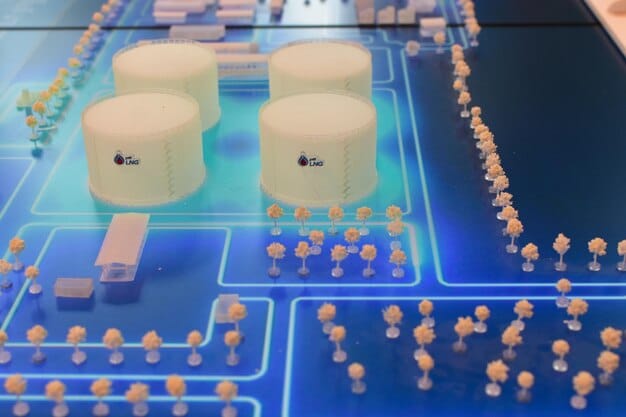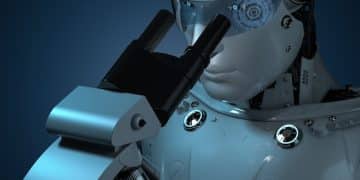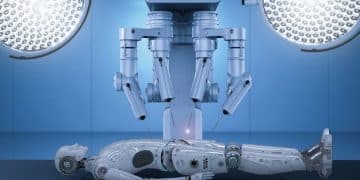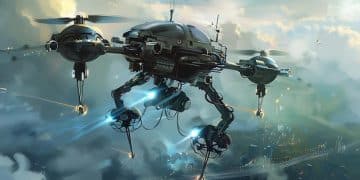US Robotics Research Grants: AI Robotics Funding Announced

The U.S. government has allocated $50 million in robotics research grants, specifically targeting AI-driven projects, to significantly advance the nation’s capabilities in autonomous systems and intelligent robotics across various critical sectors including manufacturing, defense, and healthcare.
The landscape of technological innovation is constantly evolving, and at its forefront lies the remarkable progress in robotics. A recent announcement has sent ripples of excitement through the scientific community: a substantial allocation of US Robotics Research Grants: $50 Million Available for AI-Driven Robotics Projects. This significant investment is poised to accelerate breakthroughs in artificial intelligence and robotics, promising transformative impacts across various sectors.
Understanding the $50 Million AI Robotics Initiative
The recent announcement of $50 million in US Robotics Research Grants specifically earmarked for AI-driven robotics projects marks a pivotal moment for innovation. This initiative is not merely about funding; it represents a strategic commitment to positioning the United States at the cutting edge of global robotics development. The scope of this funding extends across diverse applications, from enhancing industrial automation to revolutionizing healthcare delivery and fortifying national security. The potential for these grants to foster collaboration between academia, industry, and government agencies is immense, creating a fertile ground for novel solutions and technological advancements that could reshape our societies.
Strategic Goals of the Grant Program
The primary objective behind this substantial investment is to stimulate foundational and applied research that pushes the boundaries of what is currently possible with robotics and artificial intelligence. By focusing on AI, the grants aim to develop robots that can perceive, reason, learn, and adapt in increasingly complex and unstructured environments. This includes fostering capabilities in areas such as human-robot interaction, autonomous navigation, dexterous manipulation, and robust decision-making under uncertainty. The long-term vision is to create a robust ecosystem of robotics innovation that can address pressing societal challenges and create new economic opportunities.
Consider the following core areas that these grants are expected to impact:
- Enhanced Manufacturing: Developing intelligent robots that can handle intricate tasks, increasing efficiency and safety in production lines.
- Advanced Healthcare: Creating robotic assistants for surgeries, patient care, and rehabilitation, making medical procedures more precise and accessible.
- National Security & Defense: Innovating autonomous systems for reconnaissance, logistics, and hazardous environment operations, reducing human risk.
- Environmental Monitoring: Designing robots capable of collecting and analyzing data in difficult terrains, aiding conservation and disaster response.
This multi-faceted approach ensures that the investment yields comprehensive benefits, touching critical aspects of national interest and global technological leadership. The emphasis on AI-driven projects ensures that the robots developed are not just automated machines, but intelligent agents capable of learning and evolving.
The grants are designed to support a wide spectrum of research, from fundamental scientific inquiry to the development of practical prototypes. It anticipates that successful projects will demonstrate significant leaps in robotic perception, cognition, and physical interaction with the world. Furthermore, the program encourages interdisciplinary research, acknowledging that the most transformative innovations often emerge from the convergence of different fields, such as computer science, engineering, cognitive science, and materials science. This holistic outlook aims to build a resilient and inventive robotics research community.
The focus on AI-driven solutions signifies a shift towards more adaptive and intelligent robotic systems. These systems will not rely solely on pre-programmed instructions but will instead be capable of learning from their environment and experiences, making them far more versatile and effective in dynamic situations. This is crucial for applications where human intervention is impractical or unsafe. Ultimately, the $50 million investment is positioned to cultivate a new generation of robotics that can tackle the unforeseen challenges of the future.
Eligibility and Application Process for Researchers
Securing a portion of the $50 million in US Robotics Research Grants involves a meticulous application process, designed to identify the most promising and impactful AI-driven robotics projects. Understanding the eligibility criteria and navigating the application procedures are crucial first steps for any aspiring research team or institution. These grants typically target academic institutions, non-profit organizations, and sometimes commercial entities engaged in cutting-edge research and development. The specific requirements are often detailed in the official program announcements, which are made available through government research portals and specialized funding agencies.
Key Eligibility Requirements
Applicants must demonstrate significant expertise in robotics, artificial intelligence, or related fields. This usually translates to a track record of peer-reviewed publications, successful grant applications, and relevant project experience. The proposals must clearly articulate the project’s scientific merit, technological innovation, and potential for broader societal impact. Furthermore, a strong emphasis is often placed on the collaborative nature of the research, encouraging multidisciplinary teams and partnerships between academia and industry. Projects that show clear pathways to commercialization or practical implementation are often viewed favorably, aligning with the program’s goal of tangible advancements.
Common requirements include:
- Institutional Backing: Applicants typically need to be affiliated with a recognized research institution or university.
- Research Team Qualifications: Principal investigators and team members must possess demonstrated expertise in AI, robotics, and relevant engineering disciplines.
- Project Relevance: Proposed research must align directly with the program’s objectives of advancing AI-driven robotics, often specifying areas of interest such as autonomy, human-robot interaction, or novel robotic manipulation.
- Detailed Work Plan: A comprehensive plan outlining methodologies, timelines, expected outcomes, and budget justification is essential.
The application process frequently involves multiple stages, including a preliminary concept paper, followed by a full proposal submission for selected candidates. Peer review panels, comprising experts from academia, industry, and government, rigorously evaluate each proposal based on scientific rigor, innovation, feasibility, and potential impact. Transparency and clarity in presenting the research goals, methodologies, and expected outcomes are paramount. Successful applicants will often need to demonstrate not just the technical feasibility of their approach but also its scalability and potential for real-world application.
A well-structured proposal that clearly outlines the innovative aspects of the research, its potential broader impact, and the expertise of the team involved significantly increases the chances of securing funding. Researchers are encouraged to meticulously review the official guidelines and seek clarification on any ambiguities to ensure their application meets all stipulated requirements. Furthermore, articulating a clear vision for how the proposed research will contribute to the national strategic objectives in robotics and AI can set a proposal apart from the rest.
The competitive nature of these grants underscores the importance of a meticulously prepared and compelling proposal. It is not just about having a brilliant idea but also about effectively communicating its significance and feasibility. Researchers should allocate ample time for proposal development, including drafting, internal reviews, and securing necessary institutional approvals, to maximize their chances of success in this critical funding opportunity.
Impact of AI on Next-Generation Robotic Systems
The infusion of artificial intelligence is fundamentally reshaping the capabilities and applications of robotic systems, pushing them beyond mere automation into realms of adaptive intelligence and autonomy. The $50 million in US Robotics Research Grants specifically underscores this paradigm shift, signaling a national commitment to fostering robotics that can learn, reason, and interact with complex environments in ways previously unimaginable. This transformation is not limited to isolated improvements; it enables an entirely new class of robotic systems capable of performing intricate tasks, collaborating with humans, and making sophisticated decisions in dynamic, real-world scenarios.
Transformative AI Capabilities
AI algorithms, particularly in machine learning and deep learning, empower robots to analyze vast amounts of sensor data, recognize patterns, and make informed decisions without explicit programming for every possible contingency. This allows for robots that can navigate unpredictable terrains, differentiate between objects with nuanced variations, and even anticipate human intentions in collaborative workspaces. Furthermore, AI facilitates continuous learning, enabling robots to improve their performance over time through experience, leading to more robust and adaptable systems. The focus of these grants on AI integration will accelerate the development of robots that exhibit higher levels of intelligence, autonomy, and versatility across diverse applications.
Consider these transformative capabilities enabled by AI:
- Enhanced Perception: AI-powered vision and sensor fusion allow robots to interpret complex scenes, recognizing objects, people, and environments with unprecedented accuracy.
- Cognitive Robotics: Robots can process information, plan complex actions, and engage in problem-solving, moving beyond simple task execution.
- Adaptive Learning: Systems can learn from new data and experiences, improving their performance and adapting to previously unseen situations or changes in their environment.
- Human-Robot Interaction: AI enables more natural and intuitive communication, allowing robots to understand human commands, gestures, and even emotional cues.
The synergy between AI and robotics promises to unlock new frontiers in automation, allowing for greater precision and flexibility in manufacturing, more personalized care in healthcare, and enhanced safety in hazardous environments. By making robots smarter, more capable, and ultimately more autonomous, the collective impact will extend far beyond individual sectors, driving economic growth and improving quality of life. The challenge lies in developing AI models robust enough for real-world deployment, addressing issues like data bias, interpretability, and ethical considerations.
The emphasis on AI in these research grants is a clear recognition that the future of robotics hinges on their ability to think and adapt. Developing robots that can operate autonomously in unstructured environments, collaborate effectively with humans, and perform intricate tasks with minimal supervision requires advanced AI capabilities. These grants will fuel research into areas like reinforcement learning for robotic control, natural language processing for human-robot communication, and sophisticated computer vision for environmental understanding. The ultimate goal is to create robotic systems that are not just tools but intelligent partners capable of augmenting human capabilities.
This generation of AI-driven robots will be instrumental in addressing some of the most complex challenges facing society, from labor shortages in critical industries to the need for faster, more accurate data analysis in scientific research. The $50 million investment ensures that the US remains at the forefront of this technological revolution, fostering an environment where pioneering ideas can transform into practical, impactful solutions.

Key Sectors Targeted by the Robotics Grants
The strategic allocation of $50 million in US Robotics Research Grants is designed to catalyze innovation across several pivotal sectors, where AI-driven robotics can deliver profound and lasting impacts. This targeted approach ensures that the funding addresses critical national priorities, enhances economic competitiveness, and improves the lives of citizens. The sectors identified for significant investment reflect areas where automation and intelligent systems can solve complex problems, increase efficiency, and create new possibilities. From the factory floor to the operating room and beyond, the reach of these grants is broad and ambitious.
Manufacturing and Logistics
In manufacturing, AI-driven robots are poised to revolutionize production lines by increasing precision, boosting efficiency, and enhancing worker safety. These grants will support the development of collaborative robots (cobots) that can work alongside human employees, taking on repetitive or hazardous tasks. In logistics, intelligent autonomous systems can optimize supply chains, automate warehousing operations, and improve last-mile delivery. The goal is to create agile and resilient industrial ecosystems that can adapt to changing demands and global challenges, ensuring economic stability and growth. Research in this area might focus on flexible assembly lines, automated quality inspection, and intelligent inventory management systems.
Healthcare and Medicine
Robotics has already made significant inroads into healthcare, but AI integration promises to unlock even greater potential. The grants will foster research into robotic-assisted surgery, enabling greater precision and minimally invasive procedures. Beyond the operating room, AI-powered robots can assist with patient monitoring, rehabilitation therapies, and even elder care, providing support that frees up human professionals for more critical tasks. The focus is on developing systems that can enhance diagnostic accuracy, streamline clinical workflows, and ultimately improve patient outcomes, making healthcare more accessible and efficient. This could include robotic systems for drug discovery, personalized medicine, and even remote surgical capabilities.
Defense and National Security
For defense and national security, AI-driven robotics offers critical advantages in areas where human presence is risky or impractical. These grants will support the development of advanced autonomous vehicles for surveillance and reconnaissance, robotic systems for explosive ordnance disposal, and intelligent platforms for logistics and support operations. The emphasis is on creating robust, reliable, and secure robotic systems that can operate effectively in challenging environments, protecting personnel and national assets. Research in this domain often focuses on multi-robot coordination, resilient autonomy, and enhanced situational awareness through AI-powered sensor fusion.
By concentrating resources on these high-impact sectors, the US aims to accelerate the adoption of cutting-edge robotic technologies. Each sector presents unique challenges and opportunities, and the grants are structured to encourage solutions that are both scientifically innovative and practically viable. The long-term vision is to create a dynamic interplay between fundamental research and real-world application, ensuring that the investments yield tangible benefits across the economy and society. The integration of AI means these robots will be capable of more complex decision-making and learning, making them adaptable to unforeseen circumstances inherent in these vital industries.
Challenges and Opportunities in AI Robotics Research
The advent of the $50 million in US Robotics Research Grants presents both significant challenges and unparalleled opportunities for the scientific community. While the funding injection is a powerful catalyst, navigating the complexities of AI-driven robotics research requires addressing fundamental technical hurdles, ethical considerations, and the need for robust infrastructure. Simultaneously, these challenges pave the way for groundbreaking discoveries and transformative applications that could redefine industries and improve human lives. The successful utilization of these grants hinges on a clear understanding of both sides of this equation.
Overcoming Technical Complexities
Developments in AI robotics are frequently constrained by technical limitations. Issues such as real-time processing of massive datasets, ensuring robot safety in dynamic environments, and perfecting dexterous manipulation remain significant hurdles. Research funded by these grants will likely focus on improving sensor fusion and perception algorithms, enhancing robotic dexterity for unstructured tasks, and creating more resilient and fault-tolerant autonomous systems. The integration of AI also raises questions about the interpretability of robotic decisions, especially in critical applications. Furthermore, the development of robust, adaptable AI models that generalize well to novel situations is crucial, requiring advances in machine learning techniques and computational resources.
Opportunities include:
- Breakthroughs in Perception: Developing next-generation sensors and AI algorithms that allow robots to interpret and interact with their environment more accurately.
- Advanced Control Systems: Innovating new control strategies that enable robots to perform complex, nuanced tasks with greater precision and adaptability.
- Human-Robot Collaboration: Designing robots that can safely and intuitively work alongside humans, leveraging the strengths of both.
- Ethical AI Frameworks: Establishing guidelines and technical solutions to ensure AI robotics are developed and deployed responsibly, addressing issues of bias, accountability, and job displacement.
Ethical and Societal Considerations
Beyond technical challenges, the growth of AI robotics brings forth profound ethical and societal questions. Concerns about job displacement due to automation, the potential for autonomous systems in warfare, and the privacy implications of pervasive robotic sensing are critical. The grants provide an opportunity to fund research not just in technology itself, but also in the responsible development and deployment of these systems. This includes exploring ethical AI frameworks, developing policies for human-robot interaction, and fostering public understanding and acceptance of advanced robotics. Ensuring that AI robotics serves humanity’s best interests requires a proactive and thoughtful approach to these complex issues.
The opportunities presented by these grants are immense. They will likely accelerate research into fundamental AI concepts, foster interdisciplinary collaborations, and attract bright minds to the field of robotics. Furthermore, the funding can support the creation of shared research infrastructure, such as advanced testbeds and specialized datasets, which are essential for pushing the boundaries of what is possible. By addressing both the technical and societal dimensions, the grants aim to foster a future where AI robotics can realize its full potential while minimizing adverse impacts. This holistic approach is vital for sustainable innovation.
Future Outlook: AI Robotics and Economic Growth
The substantial $50 million investment in US Robotics Research Grants for AI-driven projects is not merely an allocation of funds; it is a strategic maneuver poised to significantly influence future economic growth and technological leadership. As AI capabilities continue to integrate more deeply into robotic systems, their impact will resonate across industries, creating new markets, enhancing productivity, and fostering a highly skilled workforce. The long-term vision is one where intelligent automation becomes a cornerstone of national prosperity, driving innovation from the manufacturing floor to the service sector.
Catalyzing New Industries and Job Creation
While concerns about job displacement often accompany discussions of automation, the historical pattern of technological advancement suggests that new technologies frequently create more jobs than they eliminate, albeit different ones. AI robotics is expected to spur the growth of new industries focused on robot design, programming, maintenance, and ethical oversight. The demand for skilled engineers, data scientists, and AI specialists will skyrocket, necessitating significant investment in education and workforce training programs. Furthermore, the increased productivity and efficiency brought by robotics can lower production costs, stimulate innovation, and lead to the creation of entirely new products and services, opening up previously unimaginable economic avenues.
Consider how AI robotics will contribute to economic growth:
- Increased Productivity: Robots can perform tasks faster and more accurately than humans, leading to higher output and efficiency across various sectors.
- Creation of High-Value Jobs: Demand for engineers, AI specialists, data scientists, and robotics technicians will grow, shifting the labor market towards more skilled roles.
- Innovation and New Markets: AI-driven robotics enables the development of novel products and services, opening entirely new industries and revenue streams.
- Global Competitiveness: Leadership in AI robotics strengthens a nation’s position in the global economy, attracting investment and talent.
The grants will also foster a dynamic research ecosystem, attracting top talent and capital. This concentration of expertise and resources can create innovation hubs, similar to Silicon Valley for software, that become magnets for investment and startup creation. The acceleration of AI robotics research will lead to a faster diffusion of these technologies across small and medium-sized enterprises (SMEs), further broadening economic participation and benefits. The focus on practical applications within the grant structure means that the research directly contributes to tangible economic outputs, ensuring a return on public investment.
Ultimately, the $50 million in US Robotics Research Grants is an investment in the nation’s future economic resilience and global competitiveness. By strategically funding AI-driven robotics, the US aims to secure its position at the forefront of technological innovation. This proactive approach ensures that the country is well-equipped to leverage the transformative potential of intelligent automation, creating a more prosperous, efficient, and technologically advanced society for generations to come. The emphasis on interdisciplinary research and collaboration will further accelerate this economic transformation.
Collaborative Models for Robotics Research
The advent of significant funding through the $50 million in US Robotics Research Grants underscores the critical role of collaborative models in accelerating scientific discovery and technological innovation. No single entity, whether an academic institution, a private company, or a government agency, possesses the entire spectrum of resources and expertise required to push the boundaries of AI-driven robotics alone. Multi-stakeholder partnerships are essential for fostering interdisciplinary breakthroughs, translating research into practical applications, and building a robust ecosystem for future growth. These grants are designed to encourage and leverage such collaborative synergies.
Academia-Industry-Government Partnerships
One of the most effective models for accelerating robotics research involves close collaboration between academia, industry, and government. Academic institutions bring fundamental research capabilities, theoretical insights, and a pipeline of skilled talent. Industry partners provide practical insights, real-world application contexts, and commercialization pathways, ensuring that research is relevant and scalable. Government agencies, besides providing crucial funding, often set strategic priorities and create regulatory frameworks that support innovation. The synergy between these three pillars can lead to more impactful research, faster development cycles, and more efficient technology transfer from labs to markets.
The benefits of these partnerships include:
- Shared Resources: Pooling high-cost equipment, specialized facilities, and extensive datasets that might be inaccessible to individual entities.
- Diverse Expertise: Combining theoretical knowledge from academia with practical engineering and market insights from industry, and strategic guidance from government.
- Accelerated Innovation: Reducing the time from fundamental research to practical application by integrating commercialization paths early in the development cycle.
- Workforce Development: Creating opportunities for students and early-career researchers to work on real-world problems, linking academic training with industry needs.
These collaborative frameworks extend beyond formal partnerships to include consortia, research networks, and open-source initiatives. By sharing knowledge, standardized platforms, and even datasets, the robotics community can collectively overcome challenges that might hinder individual progress. The grants will likely prioritize proposals that clearly outline strong collaborative elements, demonstrating how various partners will contribute to and benefit from the research outcomes. This collaborative spirit is essential for tackling the complex, multidisciplinary problems inherent in advanced AI robotics.
Furthermore, fostering international collaborations can also broaden the scope and impact of research. Sharing insights and best practices with global partners can accelerate solutions to universal challenges, as long as intellectual property and national security concerns are appropriately managed. The emphasis on collaboration ensures that the $50 million investment yields maximum returns, creating a vibrant, interconnected research landscape capable of delivering transformative advancements in AI robotics for years to come. This interconnectedness is critical for maintaining national competitiveness in a rapidly evolving technological landscape.
| Key Point | Brief Description |
|---|---|
| 💰 Funding Boost | $50 million allocated for AI-driven robotics research in the US. |
| 🧠 AI Focus | Targeting intelligent, adaptive, and autonomous robotic systems. |
| 🏥 Sector Impact | Key sectors include manufacturing, healthcare, and defense. |
| 🤝 Collaboration Drive | Encourages academic, industry, and government partnerships. |

Frequently Asked Questions About Robotics Grants
▼
The main objective is to accelerate research and development in AI-driven robotics. This aims to enhance the capabilities of autonomous systems across crucial sectors such as manufacturing, healthcare, and national security, ensuring US leadership in these advanced technological domains.
▼
Generally, academic institutions, non-profit organizations, and sometimes commercial entities engaged in cutting-edge robotics and AI research are eligible. Applicants must demonstrate strong research expertise, a clear project plan, and alignment with the program’s objectives.
▼
AI will enable robots to learn, reason, and adapt autonomously, moving beyond pre-programmed tasks. Funded projects will focus on developing intelligent capabilities like enhanced perception, cognitive decision-making, and seamless human-robot interaction in dynamic environments.
▼
The grants primarily target significant advancements in manufacturing and logistics, healthcare and medicine, and defense and national security. These sectors are identified for their high potential to benefit from intelligent automation and robotic systems, driving efficiency and innovation.
▼
This investment is expected to spur economic growth by creating new industries, fostering high-skilled jobs in robotics and AI, enhancing national productivity, and strengthening global competitiveness. It positions the US as a leader in future technological advancements.
Conclusion
The allocation of $50 million in US Robotics Research Grants for AI-driven projects represents a landmark commitment to the future of technology and innovation. This significant investment is poised to not only accelerate scientific breakthroughs in artificial intelligence and robotics but also to foster a future where intelligent autonomous systems can address some of the most pressing challenges facing society, from enhancing industrial productivity to revolutionizing healthcare and bolstering national security. By embracing collaborative research models and focusing on the ethical development of these powerful technologies, the United States is strategically positioning itself at the forefront of the global robotics revolution. The journey ahead promises transformative impacts, driving economic growth, creating new opportunities, and ultimately shaping a more technologically advanced and resilient future.





